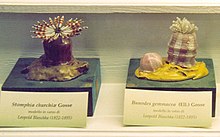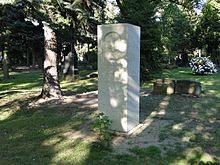Ludwig Reichenbach
Heinrich Gottlieb Ludwig Reichenbach | |
|---|---|
ornithologist | |
| Author abbrev. (botany) | Rchb. |
| Signature | |
Heinrich Gottlieb Ludwig Reichenbach (8 January 1793 – 17 March 1879) was a German
Early life
Born in
Glass sea creatures

Director of the natural history museum in

Enchanted by the botanical models and positive that Leopold held the key to ending his own showcasing issue, in 1863
Sadly, however, the original six glass sea anemones purchased by Ludwig Reichenbach in 1863 as well as the rest of that first collection was destroyed in the
Later career

He was later the founder of the
Honors
He was honoured by having several plants and animals named after him including
Death

Reichenbach died in 1879 and was interred in the Trinity Cemetery in Dresden Johannstadt. The tomb, however, was cleared after abandoning the right to use. However, the cemetery administration had not awarded the grave site, so that at the initiative of the Senckenberg Natural History Collections in Dresden, a stele was erected, which was unveiled on September 11, 2011.
Publications
- Lepidoptera Jenaische Allgemeine Literatur-Zeitung (1817)
- Reichenbach, Heinrich Gottlieb Ludwig (1828). Conspectus regni vegetabilis per gradus naturales evoluti (in Latin). Leipzig: Carolum Cnobloch.
- Flora germanica excursoria (1830–32, 2 tomes)
- Flora exotica (1834–36)
- Flora germanica exsiccata (1830–45); Exsiccata
- Übersicht des Gewächsreichs und seiner natürlichen Entwickelungsstufen (1828)
- Handbuch des natürlichen Pflanzensystems (1837)
- Das Herbarienbuch (1841)
- Abbildung und Beschreibung der für Gartenkultur empfehlenswerten Gewächse (1821–26, with 96 plates)
- Monographia generis Aconiti (1820, with 19 plates)
- Illustratio specierum Aconiti generis (1823–27, with 72 plates)
- Iconographia botanica s. plantae criticae (1823-1832, with 1,000 plates)
- Iconographia botanica exotica (1827–30)
- Regnum animale (1834–36, with 79 plates)
- Deutschlands Fauna (1842, 2 tomes)
- Vollständigste Naturgeschichte des In- und Auslandes (1845–54, 2 volumes in 9 tomes with more than 1,000 plates)
See also
References
- ^ "Lichenes exsiccati collecti atque descripti auctoribus L. Reichenbach et C. Schubert. Die Flechten in getrockneten Exemplaren, gesammelt und beschrieben von L. Reichenbach und C. Schubert: IndExs ExsiccataID=419365763". IndExs – Index of Exsiccatae. Botanische Staatssammlung München. Retrieved 14 April 2024.
- ^ Triebel, D. & Scholz, P. 2001–2024 IndExs – Index of Exsiccatae. – Botanische Staatssammlung München: http://indexs.botanischestaatssammlung.de. – München, Germany.
- ^ "Blaschka Invertebrate Models".
- ^ a b "The Blaschka Archive - Corning Museum of Glass".
- ^ a b Harvard University Herbaria and Botany Libraries
- ^ a b "Leopold + Rudolf Blaschka {...} The Glass Aquarium {...}". Design Museum (designmuseum.org). Retrieved 2015-06-10.
- ^ "All About Glass - Corning Museum of Glass".
- ^ a b "A Tale of Two Glassworkers and Their Marine Marvels - Science Friday".
- ^ "Förderverein "Naturwissenschaftliche Glaskunst Blaschka-Haus e. V". (The Promotional Association "Scientific Glass Art – Blaschka-Haus e. V.")". Urania-dresden.de. Archived from the original on 2014-11-29. Retrieved 2015-06-10. Short title: "Blaschka – English version". Translation by Peter Silbernagl. Lead sentence: "In September 2000, an association was founded in Dresden-Hosterwitz with the aim to establish a museum-type memorial for the work of Leopold and Rudolf Blaschka and to treasure the memory of those two glass-artists." Earliest English-language title: The Association "Naturwissenschaftliche Glaskunst – Blaschka-Haus e.V.". Johanna Dühning, Chairman of the Association; translation by Benjamin Pentzold (archived 2002-09-10).
- ^ a b Museum of Natural History Berlin, Historical collection of pictures and writings - Katalog über Blaschka's Modelle, L. Blaschka, Dresden, 1885
- ^ "Sea creatures of the deep - the Blaschka Glass models".
- ^ "Exhibitions - Corning Museum of Glass".
- ^ "Förderverein "Naturwissenschaftliche Glaskunst Blaschka-Haus e. V". (The Promotional Association "Scientific Glass Art – Blaschka-Haus e. V.")". Urania-dresden.de. Archived from the original on 2014-11-29. Retrieved 2015-06-10.
Short title: "Blaschka – English version". Translation by Peter Silbernagl. Lead sentence: "In September 2000, an association was founded in Dresden-Hosterwitz with the aim of establishing a museum-type memorial for the work of Leopold and Rudolf Blaschka and to treasure the memory of those two glass-artists."
Earliest English-language title: The Association "Naturwissenschaftliche Glaskunst – Blaschka-Haus e.V.". Johanna Dühning, Chairman of the Association; translation by Benjamin Pentzold (archived 2002-09-10). - ^ "Leopold + Rudolf Blaschka {...} The Glass Aquarium {...}". Design Museum (designmuseum.org). Retrieved 2015-06-10.
- ^ "Blaschkas Around the World".
- ^ National Academy of Sciences Biographical Memoir
- ISBN 1-84246-085-4.
External links
 Media related to Ludwig Reichenbach at Wikimedia Commons
Media related to Ludwig Reichenbach at Wikimedia Commons- Biography (in German)
- The Blaschka Archive
- Works of Reichenbach at the Open Library
- The Story of Rudolf and Leopold Blaschka
- Blaschkas’ Glass Models of Invertebrate Animals (1863–1890)
